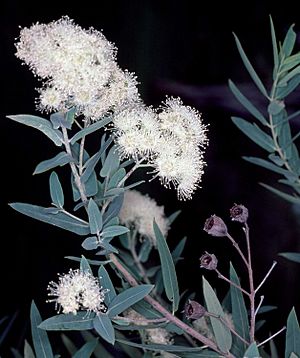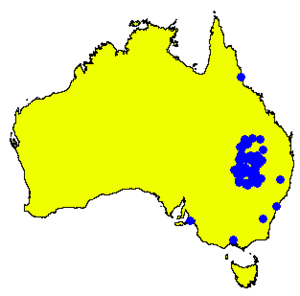Coolabah apple facts for kids
Quick facts for kids Coolabah apple |
|
|---|---|
 |
|
| Flowers and fruit of the Coolabah apple tree in the ANBG | |
| Scientific classification | |
| Genus: |
Angophora
|
| Species: |
melanoxylon
|
 |
|
| Where the Coolabah apple grows in Australia | |
| Synonyms | |
|
|
The Angophora melanoxylon, often called the Coolabah apple, is a type of small to medium-sized tree. It grows only in eastern Australia. This tree has rough, stringy bark on its trunk and branches. Its adult leaves are long and narrow. It produces white or creamy white flowers and fruit shaped like cups or barrels.
Contents
What the Coolabah Apple Looks Like
The Coolabah apple tree usually grows up to 15 meters (about 49 feet) tall. It has rough, stringy, greyish bark on its trunk and branches. This tree can also grow a special woody lump at its base called a lignotuber. This helps it regrow after fires.
Leaves
Young Coolabah apple plants and new shoots have leaves that attach directly to the stem. These leaves are shaped like a spear and are about 4.5 to 10 centimeters (1.8 to 3.9 inches) long and 1.2 to 2.5 centimeters (0.5 to 1 inch) wide. They grow in opposite pairs.
Adult leaves also grow in opposite pairs. They are a dull grey-green to green color, but lighter on the underside. These leaves are long and narrow, about 3 to 9 centimeters (1.2 to 3.5 inches) long and 0.6 to 2.2 centimeters (0.2 to 0.9 inches) wide. Some leaves attach directly to the stem, while others have a small stalk up to 1 centimeter (0.4 inches) long.
Flowers and Fruit
The flowers of the Coolabah apple grow in groups at the ends of the branches. Each group has three or seven flower buds. These buds are round, about 4 to 6 millimeters (0.16 to 0.24 inches) long and 4 to 7 millimeters (0.16 to 0.28 inches) wide. They have ribs on their base.
The petals of the flowers are white or creamy white. They are about 3 to 4 millimeters (0.12 to 0.16 inches) long and wide. Coolabah apple trees have been seen flowering in December. After flowering, the tree produces woody fruit. These fruits are shaped like cups, cylinders, or barrels. They are about 8 to 13 millimeters (0.31 to 0.51 inches) long and 7 to 11 millimeters (0.28 to 0.43 inches) wide.
How it Got its Name
The Coolabah apple was first officially described in 1900. A scientist named Richard Thomas Baker gave it its formal scientific name, Angophora melanoxylon. He wrote about it in a scientific publication called the Proceedings of the Linnean Society of New South Wales.
Where the Coolabah Apple Lives
The Coolabah apple tree grows in deep, sandy soils. You can find it in dry areas of eastern Australia. It grows in places like Pilliga, Coolabah, and Bourke in New South Wales. It also grows in Cunnamulla, Augathella, and St George in Queensland.
Conservation Status
The Coolabah apple is not considered to be in danger. In Queensland, the government has classified it as being of "least concern." This means there are plenty of these trees, and they are not at risk of disappearing.


